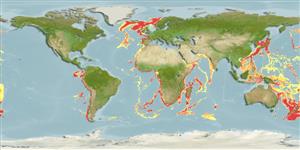Elasmobranchi (squali e razze) (sharks and rays) >
Squaliformes (Sleeper and dogfish sharks) >
Centrophoridae (Gulper sharks)
Etymology: Centrophorus: centr[um] (L.), prickle or sharp point; phorus, from phoreus (Gr.), bearer or carrier, referring to grooved spines on dorsal fins. (See ETYFish); squamosus: squama (L.), scale; -osus, Latin suffix connoting fullness, i.e., scaly, referring to its large scales. (See ETYFish).
More on author: Bonnaterre.
Environment: milieu / climate zone / depth range / distribution range
Ecologia
marino batidemersale; distribuzione batimetrica 145 - 2400 m (Ref. 6871). Deep-water; 69°N - 54°S, 92°W - 176°W
Atlantic, Indian, west and southeast Pacific Oceans.
Length at first maturity / Size / Peso / Age
Maturity: Lm 126.1, range 110 - 158 cm
Max length : 164 cm TL maschio/sesso non determinato; (Ref. 58048)
Spine dorsali (totale): 2; Raggi dorsali molli (totale): 0; Spine anali 0; Raggi anali molli: 0. A large gulper shark with a short, broad snout, a long, low 1st dorsal fin, short pectoral rear tips, and large, rough, leaf-like denticles (Ref. 5578). Dark grey or chocolate brown in color (Ref. 5578).
Found on or near the bottom of continental slopes; also found pelagically in the upper 1,250 m of water 4,000 m deep (Ref. 31367). Presumably feeds on fish and cephalopods (Ref. 6871). Ovoviviparous (Ref. 50449). Utilized and fishmeal and dried salted for human consumption (Ref. 247); meat and fins (low value) and liver oil (very high value), and occasionally for its mature eggs (Ref.58048).
Ovoviviparous, embryos feed solely on yolk (Ref. 50449). Young numbers 5-8 in a litter (Ref. 6871). Size at birth 35-43 cm (Ref. 26346). Distinct pairing with embrace (Ref. 205).
Compagno, L.J.V., 1984. FAO Species Catalogue. Vol. 4. Sharks of the world. An annotated and illustrated catalogue of shark species known to date. Part 1 - Hexanchiformes to Lamniformes. FAO Fish. Synop. 125(4/1):1-249. Rome, FAO. (Ref. 247)
IUCN Red List Status (Ref. 130435)
Threat to humans
Harmless
Human uses
Pesca: scarso interesse commerciale
Informazioni ulteriori
BibliografiaAcquacolturaProfilo di acquacolturaVarietàGeneticaElectrophoresesEreditarietàMalattieElaborazioneNutrientsMass conversion
Strumenti
Special reports
Download XML
Fonti Internet
Estimates based on models
Preferred temperature (Ref.
123201): 4.1 - 10.6, mean 7 °C (based on 498 cells).
Phylogenetic diversity index (Ref.
82804): PD
50 = 0.5001 [Uniqueness, from 0.5 = low to 2.0 = high].
Bayesian length-weight: a=0.00257 (0.00155 - 0.00426), b=3.20 (3.05 - 3.35), in cm total length, based on LWR estimates for this species & (Sub)family-body (Ref.
93245).
Trophic level (Ref.
69278): 4.5 ±0.3 se; based on diet studies.
Resilienza (Ref.
120179): Basso, tempo minimo di raddoppiamento della popolazione 4.5 - 14 anni (tmax=71; K=0.04-0.05; Fec=5-8).
Prior r = 0.14, 95% CL = 0.03 - 0.70, Based on 1 stock assessment.
Fishing Vulnerability (Ref.
59153): Very high vulnerability (86 of 100).
Climate Vulnerability (Ref.
125649): Moderate vulnerability (38 of 100).
Nutrients (Ref.
124155): Calcium = 4.77 [0.98, 25.62] mg/100g; Iron = 0.271 [0.064, 0.902] mg/100g; Protein = 19.9 [17.6, 22.0] %; Omega3 = 0.294 [0.108, 0.950] g/100g; Selenium = 20.9 [6.4, 61.7] μg/100g; VitaminA = 10.7 [2.2, 53.2] μg/100g; Zinc = 0.248 [0.120, 0.482] mg/100g (wet weight); based on
nutrient studies.
